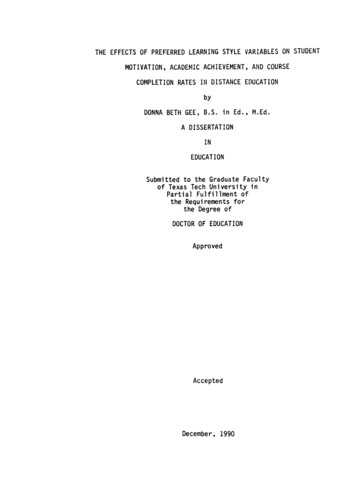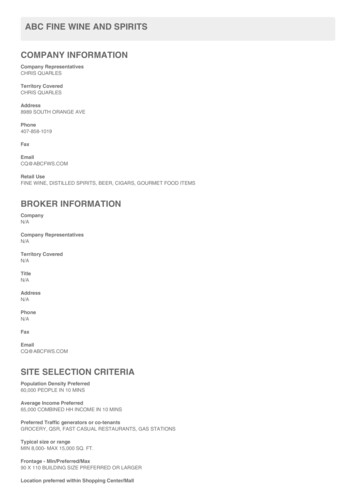
Transcription
THE EFFECTS OF PREFERRED LEARNING STYLE VARIABLES ON STUDENTMOTIVATION, ACADEMIC ACHIEVEMENT, AND COURSECOMPLETION RATES IN DISTANCE EDUCATIONbyDONNA BETH GEE, B.S. in Ed., M.Ed.A DISSERTATIONINEDUCATIONSubmitted to the Graduate Facultyof Texas Tech University inPartial Fulfillment ofthe Requirements forthe Degree ofDOCTOR OF EDUCATIONApprovedAcceptedDecember, 1990
Zol,, ,ACKNOWLEDGEMENTSr.First and foremost, I would like to express my deepest love andappreciation to my husband, Billy, for his love, encouragement, andsupport throughout this project.I would also like to thank mydaughter, Cassandra, for the joy and moments of relief she providedduring this time.I would not have completed this endeavor without thelove and support of my family.In addition, I would like to extend my thanks and appreciation tomy co-chairpersons. Dr. Jacqueline O'Dell and Dr. Larry Hovey, and tothe members of my doctoral committee. Dr. Charles Geer, Dr. RobertPrice, and Dr. Joe Cornett for their advice, assistance, and friendshipthroughout this project.I would also like to thank Dr. Bruce Barker,Dr. Dee LaMont Johnson, Dr. Barbara Hyink, and Dr. Jerry Willis fortheir assistance, guidance, and encouragement.In addition, I wouldlike to thank the students who participated in my research.Thisproject would not have been possible without their cooperation andparticipation.My sincerest thanks and gratitude go to those mentionedand those whom I may have failed to mention.11
CONTENTSLIST OF TABLESivCHAPTERI. GENERAL NATURE AND PURPOSE OF THE STUDYIntroduction11Issues in Traditional and DistanceEducation Environments7Purpose of the Study10II. REVIEW OF RELATED LITERATURE11Introduction11Distance Education12Overview of the History of DistanceEducation Technology13Distance Education Technologies15Need for Distance Education19Instructional Design and Learning ConditionConsiderations21Designing Instructional ProgramsDelivering the Conditions ofLearningIndividual Learner Characteristics andTheir Effect on LearningLearning With Distance EducationTechnologies in a Distance EducationClassroom Environment Compared to aTraditional ClassroomCharacteristics of InstructionalTechnologies Used in the PresentStudySummary212224353640111
Ill. METHODOLOGY43Subjects43Instruments44Student Data Profile Survey44Course Pretest44The Canfield Learning Styles Inventory46Course Posttest49Course Follow-Up ment of the Data53Contribution of the Study55IV. PRESENTATION AND ANALYSIS OF THE DATA56Introduction56Statistical Procedures56Analysis of Covariance57t-Tests57Course Completion Rates61Percentage Rates61Descriptive Data75Summary of Findings76V. SUMMARY, FINDINGS. CONCLUSIONSAND RECOMMENDATIONS79Summary79Findings79iv
Conclusions81Recommendations83Suggestions for Future Research85LIST OF REFERENCESAPPENDIX89100
LIST OF TABLES1.ANALYSIS OF COVARIANCE FOR ON-CAMPUS AND DISTANCEEDUCATION REMOTE CLASSROOM GROUP COURSE POSTTESTSCORES CONTROLLING FOR COURSE PRETEST SCORES58t-VALUE FOR THE COURSE FOLLOW-UP SURVEY OF ON-CAMPUSAND DISTANCE EDUCATION REMOTE CLASSROOM GROUPS58t-VALUE FOR THE COURSE CONTENT SCORES OF THE COURSEFOLLOW-UP SURVEY BETWEEN ON-CAMPUS AND DISTANCEEDUCATION REMOTE CLASSROOM GROUPS59t-VALUE FOR THE LEARNER OPPORTUNITY SCORES OF THECOURSE FOLLOW-UP SURVEY BETWEEN ON-CAMPUS ANDDISTANCE EDUCATION REMOTE CLASSROOM GROUPS60t-VALUE FOR THE MODE OF DELIVERY MEDIA SCORES OF THECOURSE FOLLOW-UP SURVEY BETWEEN ON-CAMPUS ANDDISTANCE EDUCATION REMOTE CLASSROOM GROUPS606.ON-CAMPUS LEARNING STYLE COURSE POSTTEST SCORES627.DISTANCE EDUCATION REMOTE LEARNING STYLE COURSEPOSTTEST SCORES63ON-CAMPUS LEARNING STYLE COURSE FOLLOW-UP SURVEYSCORES64DISTANCE EDUCATION REMOTE LEARNING STYLE COURSEFOLLOW-UP SURVEY SCORES65ON-CAMPUS LEARNING STYLE COURSE CONTENT SCORES OF THECOURSE FOLLOW-UP SURVEY66DISTANCE EDUCATION REMOTE LEARNING STYLE COURSE CONTENTSCORES OF THE COURSE FOLLOW-UP SURVEY67ON-CAMPUS LEARNING STYLE LEARNER OPPORTUNITY SCORES OFTHE COURSE FOLLOW-UP SURVEY68DISTANCE EDUCATION REMOTE LEARNING STYLE LEARNEROPPORTUNITY SCORES OF THE COURSE FOLLOW-UP SURVEY.69ON-CAMPUS LEARNING STYLE MODE OF DELIVERY MEDIA SCORESOF THE COURSE FOLLOW-UP SURVEY70DISTANCE EDUCATION REMOTE LEARNING STYLE MODE OFDELIVERY MEDIA SCORES OF THE COURSE FOLLOW-UPSURVEY712.3.4.5.8.9.10.11.12.13.14.15.vi
16.TABLE OF MEANS73VI1
CHAPTER IGENERAL NATURE AND PURPOSE OF THE STUDYIntroductionThere is general agreement among distance education researchers(Coggins, 1989; Conti, 1985; Fox, 1984; Weisner, 1983) that one of theimportant questions remaining to be addressed in the distance educationliterature is: What are the factors that account for adult students'success or failure in distance education learning programs?Conti (1985) and Fox (1984) have focused on three factors that havebeen identified as being critical to the design and delivery ofeffective distance education instruction.components are:Specifically, those(1) the learning styles of students; (2) teachers'abilities, interests, and teaching styles; and (3) curriculum content,processes, and methodological objectives.A precise match among thesethree components is suggested to result in the "ideal" teaching-learningsituation (Renzulli 6e Smith, 1978).In light of this information, the present study was designed to determine differences in students'achievement of course content, course completion rate, and attitudesabout learning due to variables associated with their instructionalenvironment and their individual learning styles.Thus the followingquestions present the two major issues explored in this study.1) How do learning variables in an on-campus and an off-campusdistance education classroom affect student achievement of coursecontent, course completion rates, and attitudes about learning?1 T-T(6 f i-'''
2)How do individual learning style preferences influence studentachievement of course content, course completion rate, and attitudesabout learning for students in an on-campus and off-campus distanceeducation classroom?Information is plentiful that delineates the expected result ofapplying effective teaching practices and curriculum design on studentmotivation and achievement in traditional classroom settings (Brophy 6eGood, 1986; Gagne' 6e Glaser, 1987; Romberg 6e Carpenter, 1986).Farfewer studies consider such practices and design in respect to distanceeducation (Coggins. 1989).Learning style research is also plentiful.Research that does exist on the effects of student learning stylepreferences on learning outcomes has focused primarily on identifyingstudents' learning style preferences for the purpose of prescribingeffective traditional university classroom teaching practices (Flannery6e Apps, 1987; Lee, 1984; Ommen, 1980).As Flannery and Apps (1987) comment, due to a narrow focus onregular classroom variables in traditional settings, instructionaltechnologists face two major limitations when designing effectivedistance education learning programs.These two limitations and theirspecific consequences on identifying ways to design and implementeffective distance education learning systems for individual studentsare described next.First, prior research has generally examined how adult studentslearn in traditional classroom settings to the near exclusion ofinvestigating how they may learn differently or learn best in distanceeducation settings.Thus, instructional technologists face an important
limitation when designing distance education learning systems.Thislimitation is the lack of research-based guidelines that accuratelyidentify important inherent differences that may exist betweeninstructional variables relevant to students learning in traditional anddistance education classroom settings.This limitation may haveconsequences on learning outcomes when designing distance educationprograms.Without guidelines that are specifically based on findings fromdistance education research, instructional technologists are forced tocontinue to subjectively apply findings from current traditionalclassroom research when designing distance education courses andprograms.Such designs may be less than effective because they, arebased on the assumption that the learning situation of adult studentsinvolved in distance education learning is congruent with the learningsituation that occurs in a traditional classroom setting.Projects that have attempted to directly implement educationalstrategies from traditional classrooms to distance education havegenerally not been successful.Colleges and universities in the 1920sand 1930s failed in their attempt to offer academic credit through radiotransmission (Pittman, 1989).Various technologies, such as television,interactive video systems, and teleconferencing, have had limited impacton education, especially on distance and higher education (Pittman,1989; Wagner 6e Reddy, 1989).Instructional designers of distanceeducation learning systems may therefore be producing programs that workbest in traditional classrooms rather than in a distance educationlearning situation.The design, implementation, and evaluation of
distance education learning systems require a more precise and effectivedesign strategy.A second related limitation of current distance education researchis that a majority of the studies have ignored how adult students'learning style characteristics may differently affect their educationalexperiences when pursuing instruction outside of traditional classroomsettings (Lee, 1984).Such settings may involve the use of distanceeducation technologies as primary delivery media.This limitation inthe literature also deters instructional technologists from designingand implementing effective distance education systems that adequatelysupport individxial students' needs resulting from learning stylepreferences (Armstrong, 1987; Dunn, Beaudry, 6e Klavas. 1989; Esfahani,1989).These two limitations make applying instructional prescriptionsfrom past research to the design of effective distance educationlearning environments more of a subjective task than a systematicapplication.Past research indicates that how students perceive their learningabilities and the learning demands required from different mediasignificantly influence their attitude and their overall learningperformance (Coggins, 1989).Importantly, research has shown thatdifferences in the characteristics that students attribute to differentmedia may influence their application of learning-related behaviors thataffect learning outcomes (Clark 6e Salomon, 1986; Davis, 1984; Gagne',1987; Ksobiech, 1976).For example, Ksobiech (1976) found the following in an earlierstudy involving 60 undergraduate students.Students who believed they
were to be tested on televised lessons performed better on anexamination than students who believed they were to evaluate the lessonsor who believed the lessons were for entertainment.When given theoption to review the video or narrative content of the lessons, thegroup who believed they were going to be tested over the contentconsistently opted for more narrative review.Additionally, thesesubjects also persisted longer in trying to learn than did subjects ineither of the other two groups.More recently, Salomon (1983) found that when using comparablecontent to teach conceptual information to adult learners, printmaterial was perceived to be more mentally demanding than television.Consequently, subjects applied different learning strategies to learnfrom the two media.Results of Salomon's study showed that not only didlearners in his study spend less mental effort in learning fromtelevision than from print, but their learning outcomes also differedsignificantly.In essence. Salomon's work suggests that the amount ofeffort invested by learners and the type of learning outcome theyachieve is differentially and significantly influenced by theirperceptions of media characteristics and task demands of the media.Importantly, his study demonstrates that instructional conditions can bemodified and applied to learning situations so that they have positiveaffects on learners' perception of media and media task demands.Ultimately, the effect of the learners' perceptions facilitates theirengagement in more effective instructional behaviors which, in turn,increases achievement of desired learning outcomes.
Davis (1984) reports of a later study that examined traditionallecture instruction and videodisc instruction.Findings showed studentsinvolved in learning using videodisc instruction possessed moreconfidence in their ability to learn and less concern for failure thandid students who were involved in traditional lecture instruction.Asthe author suggested, the difference for the videodisc users' increasedsense of ability over the lecture group may have been due to theirperception of control over the instructional process.It is importantto note the critical instructional variable that differed between thetwo groups was the videodisc groups' perceived need and ability tocontrol the instructional process. As evidenced by the results ofDavis' (1984) study, the videodisc users' perceived instructional needswere met by the capability of the technology to support their stoppingand reviewing the instruction as desired while using the delivery mediato learn.Concurrently, in a study investigating the effects of learnerperceptions on learning outcomes, Merrill (1984) found learners' actualcontrol over display, content, and pace of computer- assistedinstruction did not account for significant learning differences.Thevariable that did account for learning differences, however, was thelearners' perception or estimate of the amount of effort they needed toinvest for learning to occur from a particular media.The findings from these studies strongly suggest that the deliverymedia may, in fact, play a significant role in determining students'perceptions of their ability to succeed in specific instructionalsituations.More importantly, students' perceptions may in turn
differently and significantly influence their learning behaviors andconsequently their learning outcomes.Additionally, these findingssuggest that educators who are responsible for the design and deliveryof distance instruction should be cautious of subjectively assuming thatthe inherent learning behaviors and performances attributed assuccessful in a traditional classroom will be equally representative oflearning behaviors and performances that may occur in a distanceeducation classroom.Considering the unique affects that differentlearning environments, different media applications, and differentconditions of instruction may have on learner perception and behaviormay be especially important when designing technology-based learningsystems.The affects may also be equally important when implementingmedia as the major source of information transfer to students learningat a distance.To further illustrate issues that may differently affect studentperceptions and learning outcomes, the following section presentsrelated issues in traditional classroom instructional settings anddistance education environments.Issues in Traditional and DistanceEducation EnvironmentsEducational situations in traditional classrooms compared todistance education settings are distinctly different in severalimportant ways that may affect student perceptions and their learningoutcomes.For example, in a traditional classroom students andinstructor(s) are physically present in the same room when instructionis delivered.Instruction is presented in real time and students and
8instructors have mxiltiple opportunities to interact with each othervisually, audibly, and physically.In contrast, learners in distanceeducation learning situations are physically separated from instructors,peers, and other important instructional variables and materials (Benson6e Hirschen, 1987; Grieve 6e Singer, 1984; Keegan, 1986; Parkinson, 1987).In addition, opportunities for controlling the quality of interactionsmay vary significantly depending upon both the type and sophisticationof the delivery technology used and the ability of the teacher andstudents to use the media effectively in a distance education classroom(Morehouse, Hoaglund, 6e Schmidt, 1987).Recent suggestions imply that these primary differences betweeninstructional variables associated with the two types of classroomenvironments may differently affect student motivation, retention, andother affective variables usually associated with academic achievement(Barker 6e Platten, 1989; Barron, 1987; J. Smith, personal communicationJanuary 22, 1990).Presently, there is little empirical evidence tosupport or refute these assumptions.More information is needed to helpeducators in making decisions for effectively designing and implementingdistance education technologies.How do learner preferences affectattitude, retention, and learning of conceptual information wheninstruction is delivered by distance education technologies?Inanswering this question a comparison of on-campus and off-campuslearning situations is needed.The present research specificallyaddresses these important issues by examining how individual studentlearning styles affect attitude, retention, and achievement of students(on-campus and off-campus) involved in a distance education class.
Growing interest in the use of distance education technologies toprovide classroom instruction for credit and degree-seeking studentswarrants additional research before this mode of educational deliverysystem can be confidently and effectively used to enhance learning formany students (Coldeway, 1989; Duning, 1989; Saba, 1989).How candistance education environments be designed to adequately support thelearning needs of individual students?Can distance educationtechnologies be used effectively to compensate for the lack of aninstructor being physically present in a classroom?To what degree arethese questions important considerations in planning and implementingdistance education learning systems?Research findings reported by Hussein (1986) supports Moore'searlier assumption (1976 6e 1985) that perhaps distance education ingeneral, or some method of distance education, is better suited to somestudents than to others.This assumption is supported by theory andresearch results that strongly suggest individual differences do affectlearning (Cronbach 6e Snow, 1977).Research results also supporteffective instructional practices would include examination andconsideration of individual differences variables in its design(Cronbach 6e Snow, 1977; Gagne', 1968; Tobias, 1973, 1976, 1981, 1982).Currently, there are relatively few studies that have actually testedthis assumption in distance education research (Coggins. 1989).Consequently, there is little empirically based information fordetermining effective strategies for designing distance educationlearning systems that ensure many students' success.The issuesaddressed in the present study have been identified as important and
10unanswered questions in the current literature on distance education(Garrison 6e Shale, 1987) and support the purpose of the study which ispresented next.Purpose of the StudyLearners' perceptions about characteristics of instructionaldelivery media and their ability to learn using the media have beenshown to be key determinantes in predicting student motivation andsuccess in traditional classroom instructional environments (Clark 6cSalomon, 1986).This issue has not been examined in much depth orregularity in relation to how students' learning style preferences andperceptions may affect their learning outcomes in distance educationenvironments.The purpose of the present research then, is to answertwo primary questions:(1) How do learning variables in an on-campusand an off-campus distance education classroom affect studentachievement of course content, course completion rates, and attitudesabout learning?(2) How do individual learning style preferencesinfluence student achievement of course content, course completion rate,and attitudes about learning for students in an on-campus and off-campusdistance education classroom?The results of the present research haveparticular significance to the field of instructional design andtechnology and to educational psychology as the outcome of this study isto identify ways to more effectively design and implement distancelearning systems based on how individual learner characteristics affectperceptions and learning outcomes.
CHAPTER IIREVIEW OF RELATED LITERATUREIntroductionThis review of literature has three major sections which furtherdevelop the purpose of the present study which is to examine the twofollowing issues:(1) How learning variables in an on-campus and anoff-campus distance education classroom affect student achievement ofcourse content, course completion rates, and attitudes about learning;(2) How individual learning style preferences influence studentachievement of course content, course completion rate, and attitudesabout learning for students in an on-campus and off-campus distanceeducation classroom.The first section of the review provides a briefhistorical overview of the field of distance education as aninstructional method and is provided to help establish a precedence andrationale for continuing research in the area of distance education.This section also identifies and describes the major types ofinstructional delivery technologies that have been and continue to beused in distance education classrooms and their relative advantages anddisadvantages on the teaching-learning process.The second section presents instructional designconsiderationswhich identify variables usually associated with the design and deliveryof effective instruction in all learning environments.Theseconsiderations are presented to help establish guidelines foridentifying and understanding the nature and importance of theinstructional variables and the conditions of learning that are examined11
12in the present study.One of those variables in the design process isthe individual learner.Accordingly, this section builds onrecommendations of current models for designing effective instruction byreporting the findings of research that have examined the influence thatindividual learner characteristics have on learners' abilities toachieve instructional goals and objectives in different learningenvironments.The third section presents a descriptive comparison betweeninstructional variables and conditions of learning that generally existin traditional on-campus classrooms and those in distance educationremote classrooms.This section provides support for the rationale thatinherent instructional differences exist between traditional classroomsand remote distance education classrooms and may differentially supportthe needs of individual learners and result in different learning styleoutcomes for individual learners.Thus, the last section of the chapteralso reports the findings of research that have examined the influencethat individual learner characteristics play on learners' ability toachieve instructional goals and objectives in different learningenvironments.Together, these three sections develop a rationale forposing the six hypotheses stated in the following chapter.Distance EducationThis section deals with the use of technologies in distanceeducation.An overview of the history of distance education will begiven in addition to a brief description of the more popular
13technologies used in education.This section will also provide the needfor technologies in distance education.Overview of the History of DistanceEducation TechnologyThe use of sophisticated electronic technology to deliverinstruction at a distance is relatively new.a distance, however, is not new.The concept of learning atFor over 100 years, learners have beenengaged in learning at a distance through the use of traditionalcorrespondence courses where self-paced study guides and paper-basedassignments have remained the primary mode and method of instruction(Gough, 1980;Johnson 6e Amundsen, 1985).Currently, there is littleresearch-based consensus as to the absolute effectiveness of this orother forms of distance education for individual learners.While someeducators proclaim the effectiveness of distance education as a methodof instruction to meet many types of learning needs (Barker, Frisbie, 6tPatrick, 1989), others have failed to concur (Collins 6e Murphy, 1987),stating instead that learning through some types of distance educationmodes such as correspondence studies can be a frustrating and lonelyexperience for many students.Specifically, Collins and Murphy (1987)state that students who report their dislike for learning usingcorrespondence methods identify being separated from other students andtheir instructors as the primary reason for their dissatisfaction.In addition to the use of correspondence courses, radio andtelevision have also traditionally been used for delivering distanceeducation courses and programs.Beginning in the early 1950's, the useof television in education experienced extensive growth.In 1952, the
14Federal Communications Commission set aside 242 television channels foreducational purposes (Zigerell, 1984) and the Ford Foundation providedfunding to realize the vision of revolutionizing the educational systemthrough the use of educational television.In 1958, Congress passed theNational Defense Education Act in response to the launching of Sputnikby the Soviet Union and extensive funding was again provided by majorcorporations for media research (Reiser, 1987).In 1961, the Midwest Project on Airborne Television Instruction(MPATI) was funded by the Ford Foundation and the feasibility of usingtelevision to deliver educational instruction was demonstrated.Laterin 1965, Early Bird, the first commercial communication satellite(Appalachian Regional Commission, 1982; Marder, 1985) helped extend theuse of coDununication satellites to educational purposes.It was anotherdecade, however, before satellites really began to be used productivelyfor educational purposes.One of the earliest uses of satellite delivery systems was theSatellite Technology Demonstration (STD) program sponsored by theFederation of Rocky Mountain States in 1974-1975 (Grieve 6e Singer, 1984;Hosie, 1987; Norwood, 1981).The STD was an experiment whose main focuswas to offer educational programming to isolated rural populations(Hosie, 1987).Satellite transmissions included career education forjunior high students, inservice education for teachers, and programs forother adults (Filep, 1980; Hosie, 1987; Norwood, 1981).A limitation ofthe project was that interaction between students, instructors, andconsultants could only be achieved through use of live two-way audio
15communication after instruction had been broadcast and completed (Filep,1980; Hosie, 1987).In 1980, an Adult Learning Programming Department was established bythe Public Broadcasting Stations (PBS).Informal learning, collegecredit, and professional development was delivered by satellitetransmission (Hart, 1986).The mode of distance education was revolutionized by theintroduction of different types of technologies. The following sectionwill review the more popular technologies used in distance educationinstruction which have significantly influenced its current definitionand use in education.Distance Education TechnologiesIn 1990, distance education has a much broader and more powerfuldefinition than it did even ten years earlier.Due to live interactiveinstructional capabilities of advanced technologies such as satelliteT.V., audio-graphics, cable, microwave, fiber-optics, two-waytelevision, and slow scan T.V., opportunities for learning at a distanceare increased for many more people living in remote site locations thanwas ever possible before.These changes in delivery technologies haveinfluenced the definition of distance education and the nature of theenvironment in which the teaching-learning process takes place.Specifically, these changes represent a move away from defining distanceeducation as a method of instruction dependent on students' use ofpencil and paper work with long waits for feedback and few opportunitiesfor interaction with peers and instructors, to a method that is
16generally considered to consist of capabilities for providing liveinteraction where students receive immediate feedback and manyopportunities for visual interaction between their peers andinstructors.A brief identification and description of some of the types ofdistance education technologies that have influenced the conceptualchange in the definition of distance education are presented next.Theorder in which these distance education technologies are presentedreflects their relative levels of interactivity beginning withtechnologies that provide the most interactivity for teacher andlearners to those that provide the least interactivity.Two-way interactive television.Two-way interactive television wasan outcome of a demonstrated need to provide people in remote areas withinstructional transmissions during the 1950's (Lundgren, 1985).Thisform of distance education technology consists of two classrooms, eachequipped with a television monitor and video camera.In televisionclassrooms, an instructor at one location, or classroom, instructsstudents at different physical location(s).Instructors and studentsare able to see and hear each other through the use of a televisionscreen and audio speaker (Kitchen 6e Russell, 1987; McClelland, 1987).Satellite delivery.is with satellite.One means of delivering television instructionNorwood (1981) and Long (1982) describecommunication satellite as a relay device that receives signals fromearth, amplifies them, and sends them back to earth.Rotating in ageo-stationary orbit 22,300 miles directly over the earth's equator,each satell
7. distance education remote learning style course posttest scores 63 8. on-campus learning style course follow-up survey scores 64 9. distance education remote learning style course follow-up survey scores 65 10. on-campus learning style course content scores of the course follow-up survey 66 11. distance education remote learning style course .










